HONDA PRELUDE 1992 Owners Manual
Manufacturer: HONDA, Model Year: 1992, Model line: PRELUDE, Model: HONDA PRELUDE 1992Pages: 225, PDF Size: 2.1 MB
Page 1 of 225

1992 Prelude Online Reference Owner's Manual
Use these links (and links throughout this manual) to navigate through\
this reference.
For a printed owner's manual, click on authorized manuals or go to www.h\
elminc.com.
Contents
Owner's Identification Form
Introduction ........................................................................\
................................................................. i
A Few Words About Safet y........................................................................\
.........................................ii
Driver and Passenger Safety ........................................................................\
......................................3
Proper use and care of your vehicle's seat belts, and Supplemental Restr\
aint System.
Instruments and Controls........................................................................\
.........................................29
Instrument panel indicator and gauge, and how to use dashboard and steering colu\
mn controls.
Comfort and Convenience Features ........................................................................\
...................... 67
How to operate the climate control system, the audio system, and other c\
onvenience features.
Before Driving........................................................................\
.......................................................... 97
What gasoline to use, how to break-in your new vehicle, and how to load luggage and other cargo.
Driving ........................................................................\
......................................................................107
The proper way to start the engine, shift the transmission, and park, pl\
us towing a trailer.
Maintenance........................................................................\
.............................................................127
The Maintenance Schedule shows you when you need to take your vehicle to the dealer.
Appearance Care........................................................................\
......................................................175
Tips on cleaning and protecting your vehicle. Things to look for if your\
vehicle ever needs body repairs.
Taking Care of the Unexpected........................................................................\
..............................183
This section covers several problems motorists sometimes experience, and how to handle them.
Technical Information........................................................................\
.............................................203
ID numbers, dimensions, capacities, and technical information.
Warranty and Customer Relations (U.S. and Canada)................................................................215
A summary of the warranties covering your new Acura, and how to contact \
us.
Authorized Manuals (U.S. only)........................................................................\
..............................221
How to order manuals and other technical literature.
Index ........................................................................\
........................ ......................................................
I
Gas Station Information
A summary of information you need when you pull up to the gas pump.
ProCarManuals.com
Page 2 of 225

Introduction
Congratulations ! Your selection of a 1992 Honda Prelude was a wise investment. It will give you years of driving
pleasure.
To enhance the enjoyment of your new car, take time to study this manual. In it, you will learn about your car's
many conveniences and useful features. Following the service interval and maintenance recommendations will
help keep your driving trouble-free while preserving your investment.
Keep this owner's manual in your car so you can refer to it at any time. Please make sure the manual stays with
the car if you sell it. The next owner will find it just as helpful.
Several other booklets in the glove box explain the warranties that protect your Honda. We suggest you read
them carefully so you understand the coverages and the responsibilities of ownership.
When your car needs scheduled maintenance, keep in mind that your Honda dealer's service staff is specially-
trained in the service and maintenance of the many systems unique to your Honda. Your Honda dealer is
dedicated to your satisfaction and will be pleased to answer any questions and concerns.
Best wishes and happy motoring.
American Honda Motor Co., Inc. Honda Canada Inc.
31SS0604ProCarManuals.comMain Menu s t
Page 3 of 225
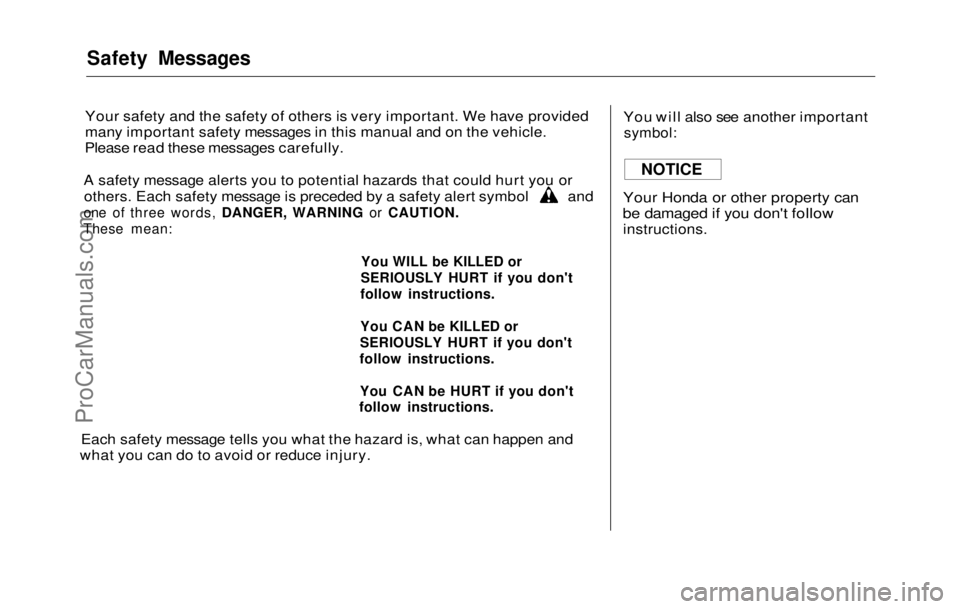
Safety Messages
Your safety and the safety of others is very important. We have provided
many important safety messages in this manual and on the vehicle.
Please read these messages carefully.
A safety message alerts you to potential hazards that could hurt you or others. Each safety message is preceded by a safety alert symbol and
one of three words, DANGER, WARNING or CAUTION.
These mean:
You WILL be KILLED or
SERIOUSLY HURT if you don't
follow instructions.
You CAN be KILLED or
SERIOUSLY HURT if you don't
follow instructions.
You CAN be HURT if you don't
follow instructions.
Each safety message tells you what the hazard is, what can happen and
what you can do to avoid or reduce injury. You will also see another important
symbol:
Your Honda or other property can
be damaged if you don't follow
instructions.
NOTICEProCarManuals.comMain Menu s t
Page 4 of 225
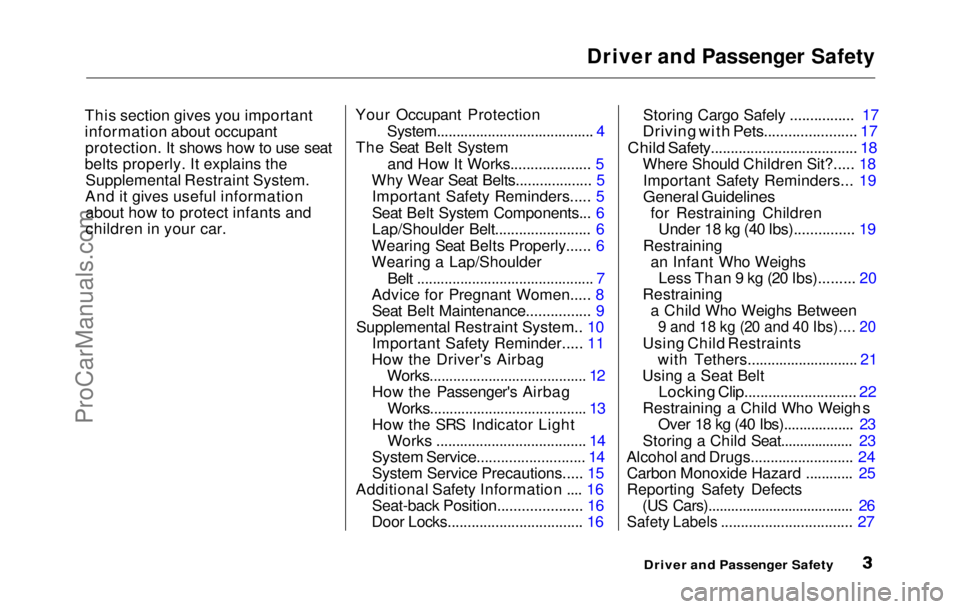
Driver and Passenger Safety
This section gives you important
information about occupant protection. It shows how to use seat
belts properly. It explains the Supplemental Restraint System.
And it gives useful information about how to protect infants and
children in your car. Your Occupant Protection
System........................................ 4
The Seat Belt System
and How It Works.................... 5
Why Wear Seat Belts................... 5 Important Safety Reminders..... 5
Seat Belt System Components... 6
Lap/Shoulder Belt........................ 6
Wearing Seat Belts Properly...... 6
Wearing a Lap/Shoulder
Belt ............................................. 7
Advice for Pregnant Women..... 8 Seat Belt Maintenance................ 9
Supplemental Restraint System.. 10 Important Safety Reminder..... 11
How the Driver's Airbag
Works........................................ 12
How the Passenger's Airbag
Works........................................ 13
How the SRS Indicator Light
Works ...................................... 14
System Service.......................... .
14
System Service Precautions..... 15
Additional Safety Information .... 16 Seat-back Position..................... 16
Door Locks.................................. 16 Storing Cargo Safely ................
17
Driving wit
h
Pets....................... 17
Child Safety..................................... 18
Where Should Children Sit?..... 18
Important Safety Reminders... 19
General Guidelines
for Restraining Children Under 18 kg (40 Ibs)............... 19
Restraining an Infant Who Weighs Less Than 9 kg (20 Ibs)......... 20
Restraining a Child Who Weighs Between
9 and 18 kg (20 and 40 Ibs).... 20
Using Child Restraints with Tethers............................
21
Using a
Seat Belt
Locking Clip............................ 22
Restraining a Child Who Weigh
s
Over 1 8
kg (40 Ibs)..................
23
Storing a
Chil
d Seat...................
23
Alcohol and Drugs..........................
24
Carbon Monoxid
e
Hazard ............
25
Reporting Safet
y
Defects
(US Cars)......................................
26
Safety Labels .................................
27
Driver an d
Passenger SafetyProCarManuals.comMain Menu s t
Page 5 of 225
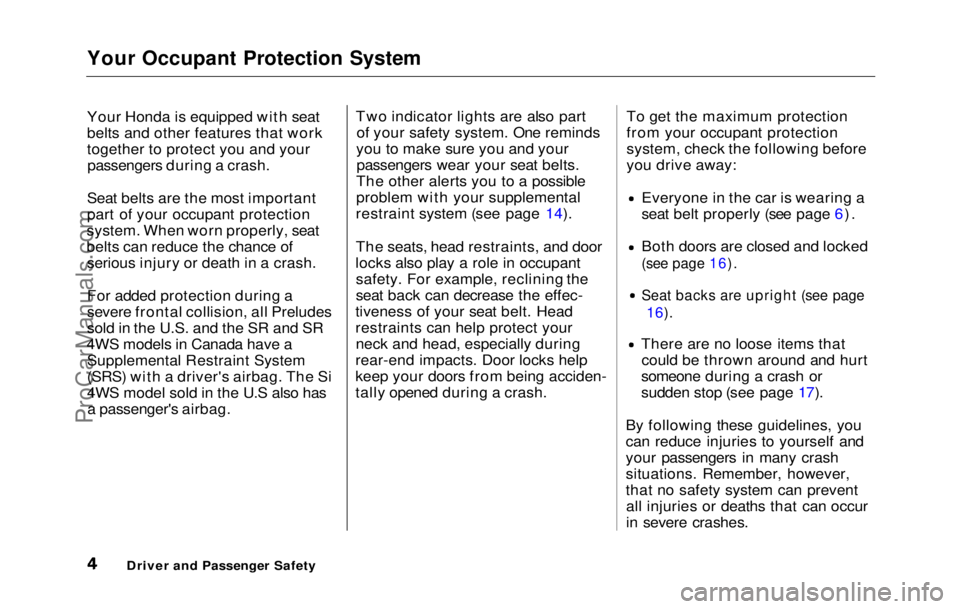
Your Occupant Protection System
Your Honda is equipped with seat
belts and other features that work
together to protect you and your
passengers during a crash.
Seat belts are the most important
part of your occupant protection
system. When worn properly, seat
belts can reduce the chance of serious injury or death in a crash.
For added protection during a
severe frontal collision, all Preludes
sold in the U.S. and the SR and SR
4WS models in Canada have a Supplemental Restraint System
(SRS) with a driver's airbag. The Si
4WS model sold in the U.S also hasa passenger's airbag. Two indicator lights are also part
of your safety system. One reminds
you to make sure you and your passengers wear your seat belts.
The other alerts you to a possible
problem with your supplemental
restraint system (see page 14).
The seats, head restraints, and door
locks also play a role in occupant safety. For example, reclining the
seat back can decrease the effec-
tiveness of your seat belt. Head
restraints can help protect your neck and head, especially during
rear-end impacts. Door locks help
keep your doors from being acciden-
tally opened during a crash. To get the maximum protection
from your occupant protection
system, check the following before
you drive away:
Everyone in the car is wearing a
seat belt properly (see page 6).
Both doors are closed and locked
(see page 16).
Seat backs are upright (see page
16).
There are no loose items that
could be thrown around and hurt
someone during a crash or
sudden stop (see page 17).
By following these guidelines, you
can reduce injuries to yourself and
your passengers in many crash
situations. Remember, however,
that no safety system can prevent all injuries or deaths that can occur
in severe crashes.
Driver and Passenger SafetyProCarManuals.comMain Menu Table of Contents s t
Page 6 of 225
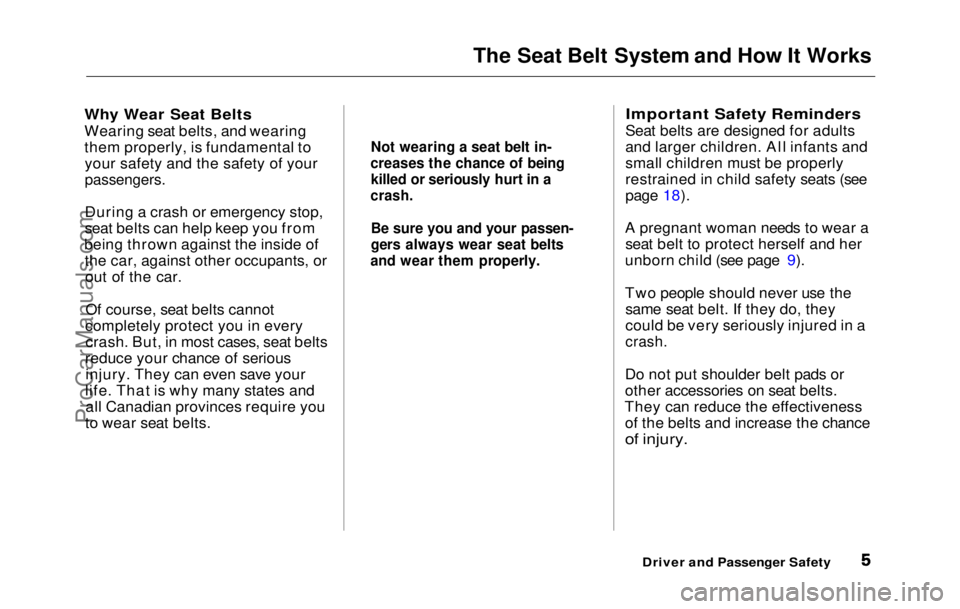
The Seat Belt System and How It Works
Why Wear
Seat Belts
Wearing seat belts, and wearing
them properly, is fundamental to your safety and the safety of your
passengers.
During a crash or emergency stop,
seat belts can help keep you from
being thrown against the inside of the car, against other occupants, orout of the car.
Of course, seat belts cannot
completely protect you in every crash. But, in most cases, seat belts
reduce your chance of serious injury. They can even save your
life. That is why many states and all Canadian provinces require you
to wear seat belts.
Important Safety Reminders
Seat belts are designed for adults
and larger children. All infants and
small children must be properly
restrained in child safety seats (see
page 18).
A pregnant woman needs to wear a seat belt to protect herself and her
unborn child (see page 9).
Two people should never use the same seat belt. If they do, they
could be very seriously injured in a
crash.
Do not put shoulder belt pads or
other accessories on seat belts.
They can reduce the effectiveness of the belts and increase the chance
of injury.
Driver and Passenger Safety
Not wearing a seat belt in-
creases the chance of being killed or seriously hurt in a
crash.
Be sure you and your passen-
gers always wear seat belts
and wear them properly.ProCarManuals.comMain Menu Table of Contents s t
Page 7 of 225
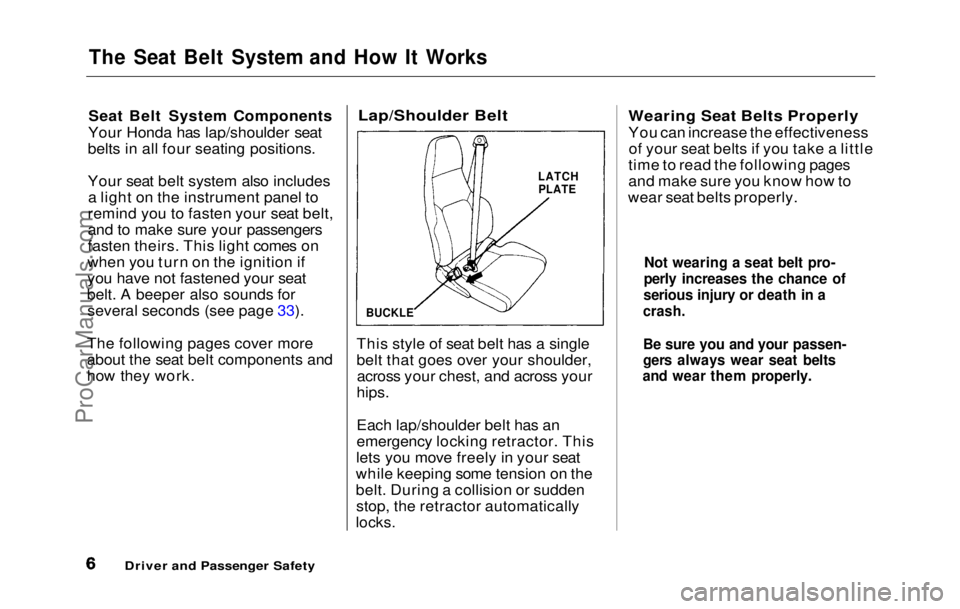
The Seat Belt System and How It Works
Seat Belt System Components
Your Honda has lap/shoulder seat
belts in all four seating positions.
Your seat belt system also includes a light on the instrument panel to
remind you to fasten your seat belt,
and to make sure your passengers
fasten theirs. This light comes on
when you turn on the ignition if
you have not fastened your seat
belt. A beeper also sounds for several seconds (see page 33).
The following pages cover more
about the seat belt components and
how they work.
Lap/Shoulder Belt
This style of seat belt has a single
belt that goes over your shoulder, across your chest, and across your
hips.
Each lap/shoulder belt has an
emergency locking retractor. This
lets you move freely in your seat
while keeping some tension on the
belt. During a collision or sudden stop, the retractor automatically
locks.
Wearing Seat Belts Properly
You can increase the effectiveness
of your seat belts if you take a little
time to read the following pages
and make sure you know how to
wear seat belts properly.
Driver and Passenger Safety
Not wearing a seat belt pro-
perly increases the chance of
serious injury or death in a
crash.
Be sure you and your passen-
gers always wear seat belts
and wear them properly.
LATCH
PLATE
BUCKLEProCarManuals.comMain Menu Table of Contents s t
Page 8 of 225
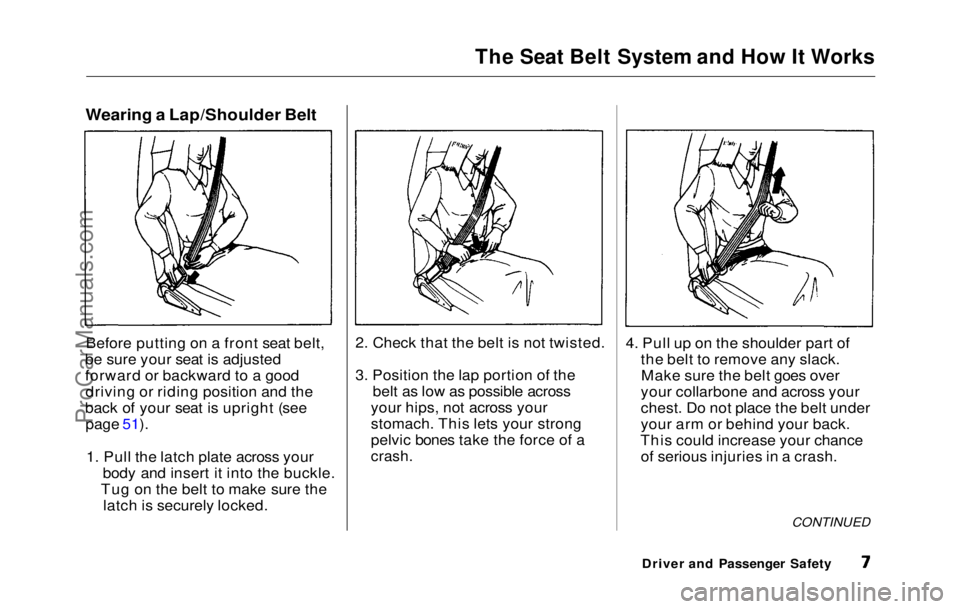
The Seat Belt System and How It Works
Wearing a Lap/Shoulder Belt
Before putting on a front seat belt,
be sure your seat is adjusted
forward or backward to a good driving or riding position and the
back of your seat is upright (see page 51).
1. Pull the latch plate across your
body and insert it into the buckle.
Tug on
the belt to make sure the
latch is securely locked.
2. Chec
k
that the belt is not twisted.
3. Position the lap portion of the
belt as low as possible across
your hips ,
not across your
stomach. This lets your strong
pelvic bones take the force of a
crash.
4. Pull up on the shoulder part of
the belt to remove any slack.Make sure the belt goes over
your collarbone and across your
chest. Do not place the belt under
your arm or behind your back.
This could increase your chance of serious injuries in a crash.
CONTINUED
Driver and Passenger SafetyProCarManuals.comMain Menu Table of Contents s t
Page 9 of 225
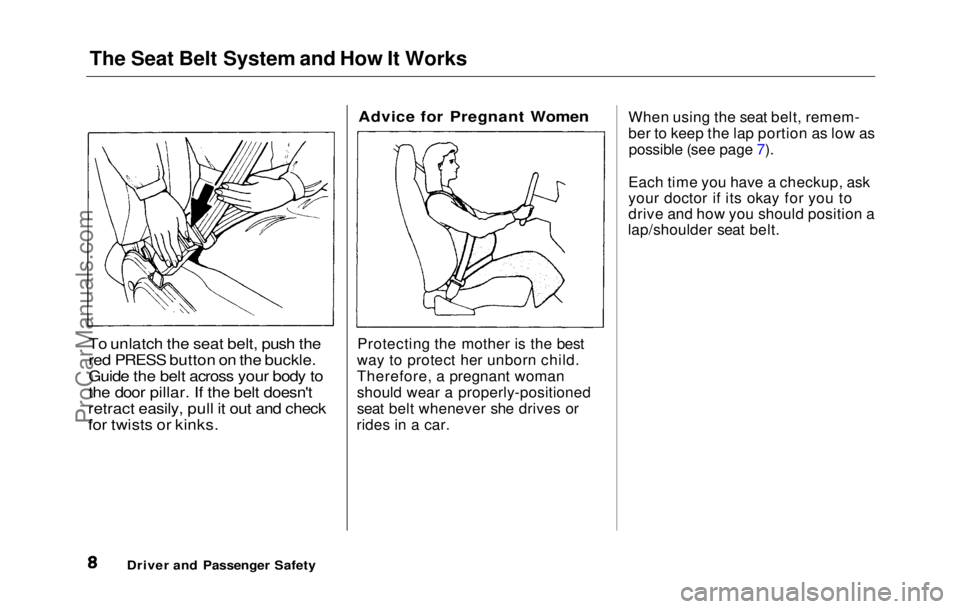
The Seat Belt System and How It Works
To unlatch the seat belt, push the
red PRESS button on the buckle.
Guide the belt across your body to
the door pillar. If the belt doesn't
retract easily, pull it out and check
for twists or kinks. Advice for Pregnant Women
Protecting the mother is the best
way to protect her unborn child.
Therefore, a pregnant woman
should wear a properly-positioned
seat belt whenever she drives or
rides in a car. When using the seat belt, remem-
ber to keep the lap portion as low as
possible (see page 7).
Each time you have a checkup, ask
your doctor if its okay for you to
drive and how you should position a
lap/shoulder seat belt.
Driver and Passenger SafetyProCarManuals.comMain Menu Table of Contents s t
Page 10 of 225
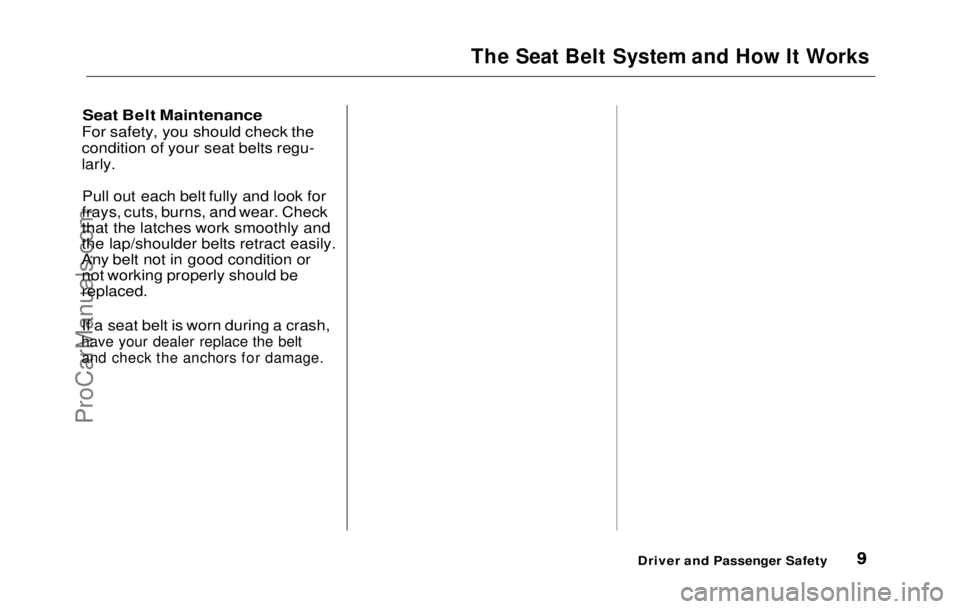
The Seat Belt System and How It Works
Seat Belt MaintenanceFor safety, you should check the
condition of your seat belts regu-
larly. Pull out each belt fully and look for
frays, cuts, burns, and wear. Check
that the latches work smoothly and
the lap/shoulder belts retract easily.
Any belt not in good condition or not working properly should be
replaced.
If a seat belt is worn during a crash,
have your dealer replace the belt
and check
the anchors for damage.
Driver and Passenger SafetyProCarManuals.comMain Menu Table of Contents s t